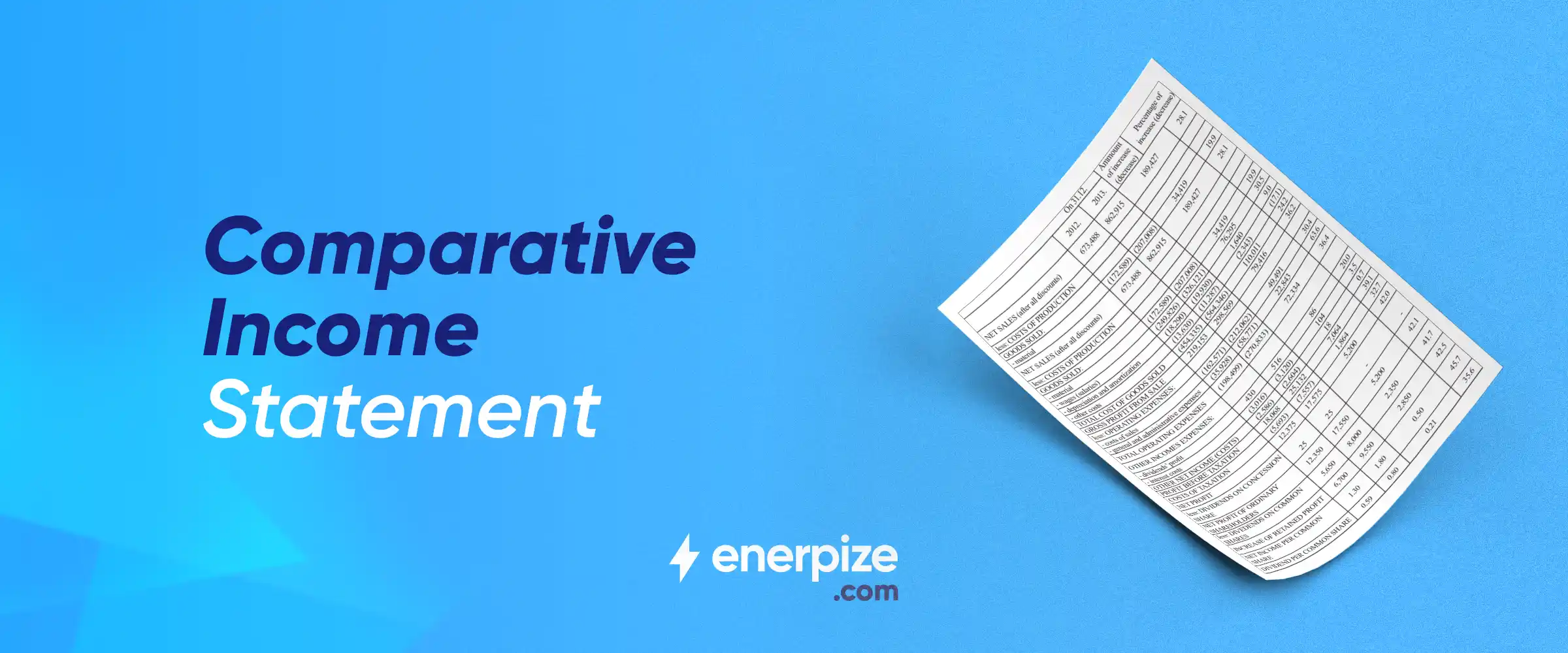Author : Mohamed Tantawy
Reviewed By : Enerpize Team
Comparative Income Statement: Importance & Preparation

Table of contents:
Financial comparisons and performance are essential in accounting planning, management, and optimization. Typically, all companies have specific financial statements to record, monitor, and report various financial data over a given period. The income statement is one such financial statement.
The income statement accounts for revenue and expenses, or profit and loss (P&L), at a given company over a specified reporting period. While indispensable, more than individual income statements over specified reporting periods are needed to perform comparative analysis across periods or companies. Here is where comparative income statements come in.
Financial planners, analysts, and auditors all need comparison and performance metrics to assess whether a given company is performing well, needs some interventions, or is freefalling. Financial analysts and controllers love comparative income statements to gain instant and long-shot insights into a company’s overall financial performance and health.
As a business owner or executive manager, comparative income statements are your holy grail to understand and monitor your business and operations - at no additional cost. You simply consolidate data from what you already have in your income statements into one income statement covering several reporting periods or companies.
Learn what a comparative income statement is, why comparative statements are important, and how to prepare one.
Key Takeaways
- Comparative income statements present financial data side by side across periods. They display income data for two or more periods simultaneously, making it easy to spot trends and changes in performance.
- Comparative income statements support informed financial analysis and decision-making. They reveal patterns in revenue and expenses, helping in assessing profitability.
- Year-over-year comparisons highlight areas of strength or concern. They help identify which parts of income are improving or declining.
- Percentage changes provide context beyond absolute figures. Including percentage changes makes it easier to judge the impact of increases or decreases in financial data.
- Comparative income statements are valuable for both internal management and external reporting. These statements aid internal performance tracking and provide clarity for investors and auditors.
What is a Comparative Income Statement?
A comparative income statement accounts for a company’s income and expenses over several reporting periods. The financial records pulled from different individual income statements are arranged in separate columns, with each column representing one accounting period and each row in a column representing a record from an account over a specified reporting period in one accounting period.
The comparative income statement is, put differently, a consolidated statement of select income statements. Financial planners, controllers, and analysts choose to perform a wide range of accounting management activities, from direct comparisons to deep-dive financial analyses.
Importance of a Comparative Income Statement
There is every benefit businesses stand to gain from using comparative income statements. Here are a few examples of why comparative income statements are important, if not indispensable:
Comparison
Comparative income statements serve one primary function: comparing individual income statements across reporting periods or companies.
As noted, comparative income statements are used by financial analysts, planners, and controllers to monitor, manage, and assess one or more given accounts, accounting periods, or companies over extended periods. This function helps identify important financial patterns, such as profitability and provides insights into broader market dynamics.
Performance
This follows intuitively from comparison. After all, comparing income statements for different accounting periods over extended reporting periods means monitoring, managing, and predicting a wide range of financial patterns, including performance.
For example, financial analysts at a given company may need to identify specific products or services contributing to that company’s profitability over a defined extended reporting period covering several periods.
Financial analysts may also need to compare a product portfolio to comparable portfolios of competing companies to understand how to improve production processes, enhance supply chain value, invest in one or more product lines, etc.
In short, comparative income statements are essential financial tools for financial analysts to manage a company’s performance beyond immediate product profitability.
Decision-Making
This should be a no-brainer. Comparative income statements, used to make comparisons and manage performance, enable the decision-making process at a micro (e.g., product or service) and macro (e.g., companywide) level.
Consider a product manager at a project management software company who wants to understand how a repurposed project management application performs, financially speaking, against several companies in a new market after being rolled out for a year.
The comparative insights a product manager obtains from a comparative statement, as opposed to an individual income statement, are invaluable not only for assessing a new product’s acceptability and profitability in that new market but, more importantly, for understanding market dynamics—and hence predicting future performance—more accurately.
Funding
Emerging companies, particularly startups, have funding front and center. Funding is more than providing for routine capital requirements to keep a business running. Instead, funding provides current shareholders and potential investors with invaluable, comparable account data to analyze a company’s financial position and decide whether more external capital needs to be secured. An up-to-date insight into a company’s financial position is essential for any company that needs to grow at scale and sustainably.
In balance, comparative income statements are indispensable financial statements for every business, particularly emerging and startup companies, to monitor and manage financial data comparisons, performance, decision-making, and funding.
Read Also: Contribution Income Statement: A Comprehensive Guide
How to Prepare Comparative Income Statements
Here's a step-by-step guide to preparing a comparative income statement:
1. Gather Financial Data
Collect the income statement data for the periods you want to compare (e.g., monthly, quarterly, or yearly). Ensure you have data for the current and previous periods (s) to make a valid comparison.
2. Set up the Income Statement Format
Create a table with the necessary columns to present the data. The columns should include:
- Period 1 (Current Year)
- Period 2 (Previous Year)
- Absolute (difference between the two periods)
- Percentage Change (used to show growth or decline percentage)
While the rows should include the standard income statement categories such as:
- Revenue: List the total revenue or sales for each period in the corresponding columns. This is the starting point for both periods.
- COGS: Enter the cost of goods sold for both periods. COGS is deducted from revenue to calculate the gross profit.
- Gross Profit: For each period, subtract COGS from revenue to find Gross Profit:
Gross Profit = Revenue − COGS
- Operating Expenses: List all operating expenses, such as selling, general and administrative expenses (SG&A). This includes costs like marketing, salaries, and rent.
- Operating Income: Subtract operating expenses from the gross profit to get Operating Income:
Operating Income = Gross Profit − Operating Expenses
- Other Income (or Expenses): Record any other income or expenses that are not related to core operations, such as interest income, gains from asset sales, or interest expenses.
- Net Income: Finally, calculate Net Income by adjusting the operating income for other income and expenses (including taxes).
Net Income = Operating Income + Other Income ÷ Expenses − Taxes
Download Now: Income and Expense Report Template
3. Calculate Absolute and Percentage Change
- Absolute: Subtract the previous period's value from the current period's value to calculate the absolute difference.
Absolute = Current Period Value − Previous Period Value
- Percentage Change: Calculate the percentage change for each line item to understand the relative difference between periods.
4. Review and Analyze
Double-check all entries and calculations. The comparative income statement is now ready for analysis and shows trends in revenues, expenses, and profits.

Comparative Income Statement Format
The previously mentioned financial data for several periods are usually listed side by side in the format of a comparative income statement, which allows a comparison of performance over time. The general format is as follows:
| Particulars | Current Period | Previous Period |
| Revenue | $xxx,xxx | $xxx,xxx |
| COGS | $xxx,xxx | $xxx,xxx |
| Gross Profit | $xxx,xxx | $xxx,xxx |
| Operating Expenses | $xxx,xxx | $xxx,xxx |
| Operating Income | $xxx,xxx | $xxx,xxx |
| Other Income/Expense | $xxx,xxx | $xxx,xxx |
| Income Before Taxes | $xxx,xxx | $xxx,xxx |
| Tax Expense | $xx,xxx | $xx,xxx |
| Net Income | $xxx,xxx | $xxx,xxx |
Comparative Income Statement Example
Here is a comparative income statement example for a company comparing its income in 2021, 2022, and 2023.
| Particulars | 2021 | 2022 | 2023 |
| Revenue | $500,000 | $600,000 | $750,000 |
| - COGS | ($200,000) | ($240,000) | ($300,000) |
| Gross Profit | $300,000 | $360,000 | $450,000 |
| - Operating Expenses | ($100,000) | ($120,000) | ($150,000) |
| Operating Income | $200,000 | $240,000 | $300,000 |
| - Interest Expense | ($20,000) | ($25,000) | ($30,000) |
| + Other Income | $10,000 | $15,000 | $20,000 |
| Income Before Taxes | $190,000 | $230,000 | $290,00 |
| - Tax Expense | ($50,000) | ($60,000) | ($80,000) |
| Net Income | $140,000 | $170,000 | $210,000 |
For a quick reference (until further analyzed below), revenue grew year-on-year from $50,000 in 2021 to $750,000 in 2023, up from $600,000 in 2022.
Gross profit also rose steadily from $300,000 in 2021 to $450,000 in 2023, up from $360,000 in 2022. The relative jump in COGS from $200,000 to $30,000 in 2021 and 2023, respectively, narrowing the profit margin year-on-year, particularly between 2021-2022 and 2022-2023.
Operating Expenses also rose but at a slower rate than revenue, indicating an improved profitability rate year-on-year.
The bottom line, Net Income, grew consistently and at a growing rate, indicating healthy profit growth.
How to Analyze Comparative Income Statement
Two common methods are used to analyze comparative income statements as follows:
Horizontal Analysis
The horizontal analysis is performed by accounting for financial records in absolute and percentage values in individual income statements. This method helps analysts monitor seasonal or persistent growth patterns instantly and conveniently. The horizontal analysis is sometimes called a trend analysis because analysts can identify specific trends within and across financial data over several reporting periods.
The formula used to calculate dollar amount change is as follows:
Dollar Change = Amount of Item in Current Year – Amount of Item in Base Year
The formula used to calculate percentage change in comparative income statement is as follows:
Percentage Change = (Dollar Change / Amount of Item in Base Year) X 100
The dollar change over 2021-2023 can be calculated as follows:
| Account | 2021 | 2022 | 2023 | Dollar Change (2021-2023) |
| Revenue | $500,000 | $600,000 | $750,000 | 250,000 |
| Gross Profit | $300,000 | $360,000 | $450,000 | 150,000 |
| Income Before Taxes | $190,000 | $230,000 | $290,00 | 100,000 |
| Net Income | $140,000 | $170,000 | $210,000 | 70,000 |
The percentage change over 2021-2023 can be calculated as follows:
| Account | 2021 | 2022 | 2023 | Percentage Change (2021-2023) |
| Revenue | $500,000 | $600,000 | $750,000 | 50% |
| Gross Profit | $300,000 | $360,000 | $450,000 | 50% |
| Income Before Taxes | $190,000 | $230,000 | $290,00 | 52.6% |
| Net Income | $140,000 | $170,000 | $210,000 | 50% |
The above figures, in dollar amount and percentage, show a 50% roughly over 2021-2023, indicating sound financial performance of double-digit growth year-on-year.
Vertical Analysis
In contrast, the vertical analysis method accounts for financial data as a percentage only. That way, comparisons between companies of different sizes and each line time’s relative size can be made. The vertical analysis is sometimes called a timeline analysis because analysts can assess individual statements over a specified reporting period compared to one another.
The formula used to calculate percentage change is as follows:
Percentage Change = Line Item / Revenue x 100
The percentage change over 2021-2023 can be calculated as follows:
| Account | 2021 | 2022 | 2023 |
| Revenue | $500,000 | $600,000 | $750,000 |
| Gross Profit | $300,000 | $360,000 | $450,000 |
| Income Before Taxes | $190,000 | $230,000 | $290,00 |
| Net Income | $140,000 | $170,000 | $210,000 |
| Revenue | 100% | 100% | 100% |
| Gross Profit | 60% | 60% | 60% |
| Income Before Taxes | 38% | 38.33% | 38.66% |
| Net Income | 28% | 28.33% | 28% |
Read Also: Comparative Balance Sheet: A Comprehensive Guide
How Enerpize Can Help You in Comparative Income Statements
Enerpize is accounting-geared. That means you, as a business owner or executive manager, should rest assured your accounting operations are managed end-to-end smoothly, quickly, and compliantly.
As a leading online accounting software, Enerpize is best positioned to create and manage all your comparative income statements needs by:
- Creating automated or manual general and subledger records.
- Generating automated, shareable, and printable financial statements and reports to suit every business need and regulatory requirements.
- Listing expenses and revenue from any device or platform anywhere, at any time.
- Generating custom displays of revenue, expenses, net income, and more over preset reporting periods and generating custom reports for internal use or regulatory purposes.
- Tracking operation expenses within one or more markets to control costs over any specified reporting period.
- Listing all your identified account names and make your designated accounts available to any number of internal stakeholders to record, modify, and audit some or all transactions.
- Adjusting Enerpize account settings automatically or manually to create custom (daily, weekly, or monthly) recurring-expense accounts.
- Generating comparative income and lifetime company statements spanning as long as you want to gain long-range insights into your business, market dynamics, and growing revenues or expenses anywhere you operate.
- Calculating tax options (GST, VAT, EXP, etc.) informed by your comparative income statements created for your custom reporting periods.
Enerpize has set many businesses on the right track to sound and compliant accounting operations and practices.
Get a sense of what Enerpize can offer to scale your comparative income statements to make business and market insights a routine, not hiccups of unplanned or predictable chances.
Try our 14-day free account and set your accounting operations on a track of growth and success.
Final Thoughts
Financial planners, analysts, and controllers all need a comprehensive record of all accounts to generate insights, make sound financial and business decisions, assess funding gaps or opportunities, and monitor financial performance.
Comparative income statements compare individual income statements over multiple reporting periods using horizontal or vertical analyses.
The horizontal analysis, aka trend analysis, creates financial records in absolute and percentage values in individual income statements. The vertical analysis, aka timeline analysis, only creates percentage financial records. Both are helpful analysis methods to provide financial analysts, controllers, and investors with long-range insights into market dynamics and operational performance across accounts and companies.
Comparative income statements are valuable financial statements every business needs to have a long-shot view of current accounts and, importantly, make sound forecasts of future account performance.
As a business owner or executive manager, you must choose your accounting partner carefully to avoid unpleasant accounting anomalies or regulatory surprises.
Comparative income statements are easy with Enerpize.
Try our accounting module to create your financial statements automatically.








